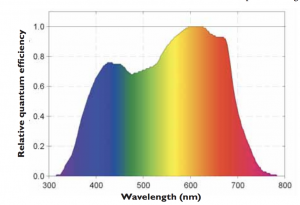- 44 reads

The following publication was authored by a team member and is relevant to lighting for plant applications. For the scientific journal articles, you may contact the senior author for an electronic copy of the manuscript. We thank Greenhouse Grower, Greenhouse Product News, GrowerTalks, and Photonics Spectra for their permission to post the article on this site. If you or your team has content relevant to lighting for plant applications that you would like posted on this site, please contact the GREENandSAVE staff.
By Erik Runkle
The high pressure sodium lamp is the most widely used light source for supplemental lighting in greenhouses. On a relative basis, it is moderately efficient, has a long bulb life and emits light that is rich in orange and deficient in blue and red. Light-emitting diode (LED) technology is advancing in several ways, including increased electrical efficiency, longevity and intensity. As LEDs advance and their costs decrease, I believe they will become the preferred light source for both low-intensity (photoperiodic) and high-intensity (photosynthetic) lighting. Incandescent lamps are making their way out of greenhouses because of their electrical inefficiency. Compact fluorescent lamps can be cost-effective substitutes, but they delay flowering in some long-day crops because they emit very little far-red light. LEDs that emit light at a low intensity are being developed to replace incandescent lamps. To inhibit flowering of short-day plants, such as poinsettias and chrysanthemum, red LEDs may be effective; for long-day plants, such as petunia and pansy, some far-red LEDs may be needed together with red ones for the desired flowering response.
Into the Crystal Ball
There is a growing number of companies that produce and/or market LEDs for plant applications. Plasma lamps are also being developed for greenhouse lighting. Most companies are focusing on developing high-intensity lighting to increase plant photosynthesis. Here are some criteria for lighting manufacturers and greenhouse growers to consider.
High electrical efficiency. This is a major reason LEDs are so promising. Although current LEDs are only as electrically efficient as HPS lamps, they’ll soon be more efficient than HPS lamps at converting electrical energy into photons of light. Th is efficiency can be quantified as micromoles of photosynthetic light (μmol·m-2·s-1) per watt of energy per area (W·m-2). The higher the value, the more efficient the lamp.
High relative quantum efficiency. The RQE describes the efficiency of particular wavelengths for driving photosynthesis. In the early 1970s, K.J. McCree published an RQE response curve of photosynthetic responses by 22 different species (Figure 1). Red light had the highest RQE, meaning that it was the most efficient at photosynthesis. Note that blue light is about 70 to 75 percent as effective as red light, and green light is even less effective.
Uniform distribution of light. Greenhouse lighting must be evenly distributed to ensure uniform crop response.
Durability and Reliability. Lamps must be engineered and constructed to optimize light output, be of high quality and withstand extreme greenhouse conditions. For example, heat must be dissipated from LEDs sufficiently so that lights operate at a favorable temperature; otherwise, their useful life decreases.
Compact size. Arrays should be as compact as possible to minimize shading to crops.
Acceptable cost. The cost of these new technologies must be low enough that their purchase price can be off set by electricity savings or improved crop growth within a reasonable period of time (e.g., within five years). Because many greenhouses use supplemental lighting for only three or four months of the year, it can take longer to get a return on investment. However, mass production and sales will rapidly reduce costs of equipping greenhouses compared to initial prototype models.
Acceptable effect of light quality on plant morphology. The spectral output of lamps can influence plant architecture, including plant height and chlorophyll concentration, which influences the greenness of leaves. Therefore, effects of lighting on growth and development must also be considered. The great flexibility of designing LEDs for specific plant requirements will allow customized designs for specific crops.
Erik Runkle is associate professor and floriculture extension specialist in Michigan State University’s department of horticulture. He can be reached at runkleer@msu.edu or 517.355.5191 ext. 1350. Thanks to Cary Mitchell of Purdue University for his critical input to this article.
More information on LED Lighting Technology for Greenhouses

